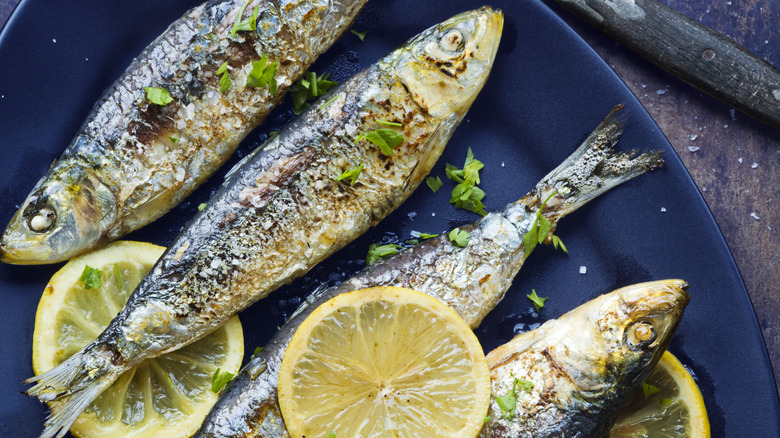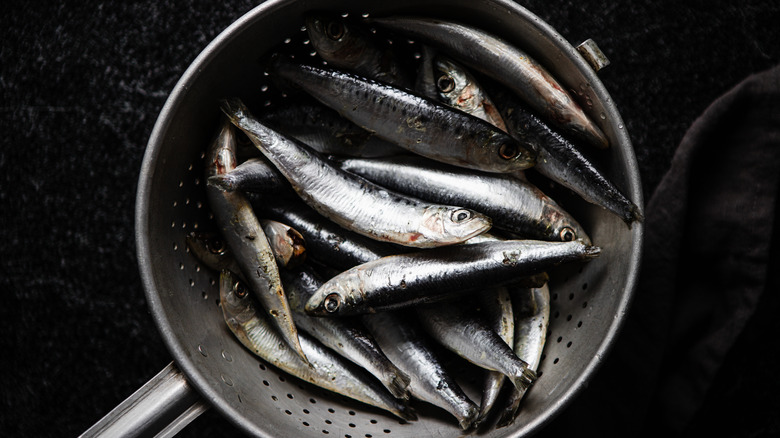How To Quickly Clean Fresh Sardines If You Don't Have A Good Knife
If you already know how to choose the best fresh sardines and have some ideas for how you'd like to cook them, you'd be forgiven for thinking all you need to do next is get cooking. However, because they're such small fish compared to other varieties people eat, cleaning sardines is the most challenging part of using them in your cooking. And that's when you have a good, sharp knife on hand. So what happens if, like most of us, you're not sharpening your knives daily? If you thought there was no way to clean a fish the size of a sardine without a razor-sharp knife, think again. The answer to your problems lies in another simple household tool: scissors.
Thanks to their size, the bones in sardines are nowhere near as large or as hard as in other commonly eaten fish. They're so innocuous that tinned sardines usually still have most of their bones, which soften even more after the sardines are sealed in tins and cooked. These soft bones are what make it possible to use scissors to clean fresh sardines — the result is a little less refined than using a knife, but it's perfect for mass fileting. Your scissors become a utility tool, making it possible to clean and debone fresh sardines using just scissors and some light fingerwork.
How to clean sardines using scissors
The first step to cleaning sardines with scissors is to descale your fish, passing the cutting edge of your scissors along each sardine from tail to head multiple times while holding them under lightly running cold water. You don't have to perfectly remove all the scales since, like the bones, they're mostly very small and are unlikely to cause much bother when eating. Handle your sardines gently throughout the cleaning process, as the flesh can become mushy if pressed too much or handled roughly, which can give them an unappetizing texture or cause them to fall apart when cooked.
You then use your scissors to snip off the heads of each sardine just below the two pectoral fins located behind the head towards the underside of the sardine. Next, snip open the belly, cut off the dorsal fin, and then use your fingers to scoop out the guts and rinse clean. As with the descaling, it's best to do this under cold running water.
The trickiest part when cleaning sardines is removing the spine, which is usually done with the hands, even if you do have a sharp knife handy. You should open up the fillets, exposing the spine, and then carefully pinch it and pry it out along the fish, then break it off at the end to release the spine from your sardine filets. Depending on your sardines' size and your planned recipe, you may not even need to do this.
Ideas for cooking with fresh sardines
One of the benefits of cleaning sardines with scissors is that with a little practice, they can do the job just as quickly, if not quicker, than a knife. That makes fresh sardines an even more appealing option for a quick meal, especially if you know how to make sure you're buying good ones.
If you want to get the best out of fresh sardines, simplicity is often the key — give those little silver beauties a chance to shine! Acid is all you need to elevate sardines; for the Mediterranean classic version, use lemon with a dash of olive oil and salt and whack them on the grill. Or dust them in flour and fry them in a pan with a shallow layer of oil. Because sardines are quite oily fish, they also work well with some good bread (in fact, a sardine sandwich once featured as Daily Meal's 'Sandwich of the Week'). However, if there's one country known for its sardines, it's Portugal, so you can't go wrong with Gordon Ramsay's recipe for grilled sardines stuffed with bell peppers and lemon-herb breadcrumbs. It's simple, but it's elevated — and of course, it has plenty of lemony acid.


